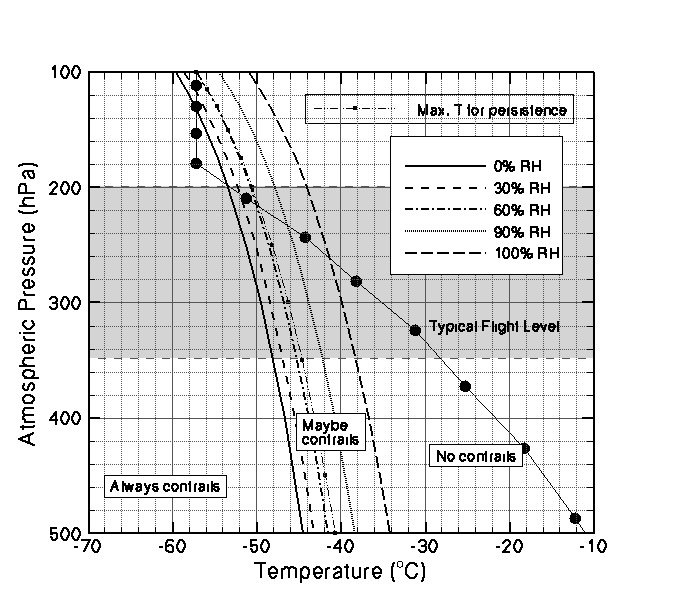Appleman Chart Teacher - Clouds Protocol
Predicting Contrails Using an Appleman Chart [Teacher]
Background: Military planners have been interested in condensation trail (contrail) forecasts since World War II. Contrails can make any aircraft easy to locate by enemy forces, and no amount of modern stealth technology can hide an aircraft if it leaves a persistent contrail in its wake. In 1953, a scientist named H. Appleman published a chart that can be used to determine when a jet airplane would or would not produce a contrail. For many years, the U.S. Air Force Global Weather Center used a similar chart to make contrail forecasts.
The first published reports of contrail formation appeared shortly after World War I. At first, scientists were not sure how contrails formed. It is now known that they are a type of mixing cloud, similar to the cloud that sometimes forms from your breath during a cold winter day. Appleman showed that when the air outside of the airplane is cold enough and moist enough, the mixture of the jet exhaust and the air would form a cloud.
Below is an example of a contrail-forecasting chart. The chart can be used to make forecasts and observations to determine whether they are true or false.
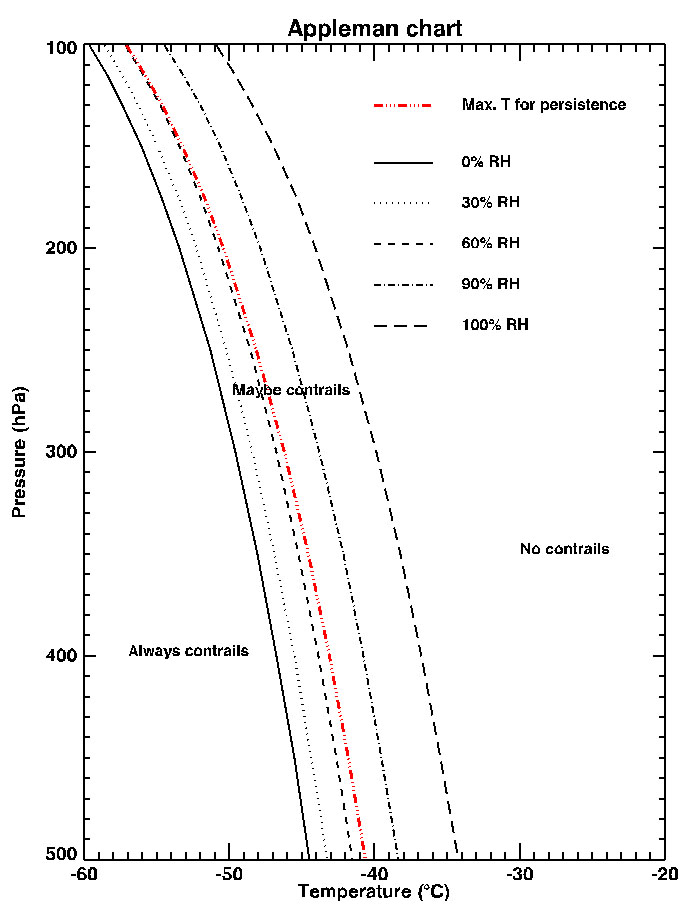
How to Use the Appleman Chart
A. Plotting the graph: Using either the temperature information provided by the teacher or the temperatures obtained from an internet location (see note below), complete the table on the "Student Data Sheet," then plot the temperatures corresponding to each pressure level on the "Appleman Chart: Student Graph Worksheet." Connect the points to create a temperature profile of the atmosphere.
[Teachers: Duplicate the data sheet and chart as needed to provide a copy of each worksheet for each separate observation.]
Note: Temperature and humidity information can be obtained from weather balloon soundings launched twice a day from several locations around the country. Several locations on the internet, including the University of Wyoming website, provide detailed sounding information. Choose the location nearest the school.
B. Using the graph: The two most important lines on the chart are the 0% relative humidity line and the 100% relative humidity line. If the atmosphere is colder than the temperature indicated by the 0% line, a contrail would form even if the relative humidity of the atmosphere were zero. By itself, the airplane will supply enough moisture to make the contrail, and no moisture is necessary from the atmosphere to form the cloud. According to the chart, contrails will always form when the temperature profile is to the left of the 0% line. If the atmosphere were warmer than the temperature indicated by the 100% line, a contrail could not form even if the relative humidity of the atmosphere were 100 percent. The combined moisture from the jet exhaust and the atmosphere will never be enough for the mixture to produce a cloud. Temperature profiles to the right of the 100% line will never form a contrail. For temperatures between the 0% and 100% lines, the possibility of a contrail forming will depend on the atmospheric moisture, represented on the chart as relative humidity. A contrail may or may not form when the temperature is between the 0% and 100% lines.
Q1: Look at the temperature profile on your chart. Is it possible for a contrail to form over your area today?
[Teachers: A suggested activity would be to have the students make forecasts over several consecutive days, and then check outside (preferably in the morning so that the information from the weather balloon sounding is more likely to be representative) each day to see if the forecast verifies. One way to make a forecast would be to plot the temperature profile on the chart. If any point in the profile lies to the left of the 0% line, then the forecast is "yes, contrails will form." If all of the points are to the right of the 100% line, the forecast is "no contrails will form." Otherwise, the forecast is "maybe." Another simple way to do the forecast would be to assume the relative humidity of the atmosphere is 30%. If any points are to the left of the 30% line, the forecast would be "yes, contrails will form." Otherwise, the forecast is "no contrails will form."]
Q2: If it is possible for a contrail to form, at what level must the airplanes fly to make a contrail?
Q3: Why might a contrail form on a day when no contrails are forecasted to form?
Q4: Why might no contrails form on a day when contrails are forecasted to always form?
For the next two questions, see "Appleman Chart Extended to Earth's Surface."
Q5: Why do airplanes not make contrails when they are flying low (shortly after takeoff or before landing)?
Q6: Can you think of a place where low-flying jet airplanes could produce a contrail?
[Teachers: For the following questions a chart with the climatological mean temperature profile should be used. Note the latitude and longitude of the school, then refer to the corresponding Temperature Profile included with the activity.]
Q7: Most commercial jets fly between 8 and 12 kilometers (26,000 and 39,000 feet, or roughly 350 hPa to 200 hPa). Suppose that all aircraft on trips across the country were required to fly at or above 11 kilometers (36,000 feet or roughly 230 hPa). Do you think the number of contrails would increase or decrease?
Q8: Suppose that all aircraft were required to fly at or below 9 kilometers (29,000 feet or roughly 310 hPa). Do you think the number of contrails would increase or decrease?
Humidity: Both the temperature and humidity of the atmosphere help to determine whether a contrail can form. As the relative humidity in the atmosphere increases, the atmosphere is able to supply more moisture into the jet aircraft exhaust plume, and a contrail is more likely to form. The temperature of the atmosphere does not have to be as cold to form contrails at 60 percent relative humidity compared to 0% relative humidity. If the relative humidity of the atmosphere were 60 percent, then a contrail can form if the atmospheric temperature is less than the temperature indicated by the 60% line (temperature profile is to the left of the 60% line).
[Teachers: Students can use humidity data to refine their contrail forecasts. For each level in the atmosphere, select the relative humidity line on the Appleman chart corresponding to measured relative humidity. If the observed temperature is less than the temperature indicated on the chart, then contrails are predicted. Let the students make forecasts over several consecutive days, and then check outside each day to see if the forecast is verified.]
Calculating Contrail Prediction Accuracy
Collect sounding data and corresponding contrail observations for at least 10 days. Record observations on the "Student Data Sheet" as before.
[Teachers: Schedule permitting, collecting data for an additional 20 days (total of 30 days) would be very useful in the calculations.]
Use the information from the Student Data Sheets to complete the following questions:
Q9: How many times were contrails predicted and they did occur? (Call this Number A).
Q10: How many times were contrails predicted and they did not occur? (Call this Number B).
Q11: How many times were contrails not predicted but they did occur? (Call this Number C).
Q12: How many times were contrail not predicted and they did not occur? (Call this Number D).
The percentage of correct forecasts is (A + D)/(A + B + C + D).
Q13: What percentage of correct forecasts did you get at your school?
The U.S. Air Force conducted studies to test the accuracy of the Appleman chart. Military pilots sometimes remark in their flight reports whether or not contrails form during their flights. Using these reports and observations of temperature, pressure and relative humidity, the Air Force found that the forecasts using the Appleman method were correct about 60 percent to 80 percent of the time. Looking more closely at the data, they found that when no contrails were forecast, the forecast was correct 98 percent of the time! However, when contrails were forecast to occur, the forecast was correct only 25 percent to 35 percent of the time, and often failed to predict the occurrence of contrails. Thus, the Appleman chart tends to underpredict the occurrence of contrails and to overpredict the non-occurrence of contrails. For this reason, the Air Force is actively investigating better ways to compute contrail formation.
Q14: How do your results compare to what the U.S. Air Force found?
Persistent Contrails
Some contrails are short and last for only a few seconds. Other contrails are very long and continue to grow long after the jet airplane has passed. Why do some contrails remain in the sky so long? Go back to the example of the cloud forming on breath during the winter. Such clouds usually disappear as soon as a person takes their next breath. The relative humidity of the winter air at the surface is usually well below 100 percent and cannot sustain a mixing cloud for a long time. The relative humidity at the altitudes where airplanes fly can sometimes be as high as 90 percent. Surprisingly, at cold temperatures ice clouds (including contrails) can form and persist at humidities lower than 100 percent. The red line (dash-double dot line) in the Appleman chart shows at what humidities contrails can persist (usually between 60 percent and 70 percent relative humidity). Thus, if the air is moist enough and colder than (temperature profile is to the left of the red line), then the Appleman chart indicates that persistent contrails can form.
[Teachers: Advanced students could use the humidity data to forecast whether persistent contrails can form.]
Extension Activity: Use the humidity data to forecast whether persistent contrails can form.
[Teachers: Here are the numbers used to create the Appleman chart. They are based on an aircraft with average engine efficiency. The temperatures are in degrees Celsius. They can be used to make an Appleman chart.]
| RH (percent) | |||||
| Pressure (hPa) | 0 | 30 | 60 | 90 | 100 |
| 30.0 | -69.61 | -68.67 | -67.36 | -64.93 | -61.74 |
| 50.0 | -65.53 | -64.54 | -63.17 | -60.64 | -57.15 |
| 100.0 | -59.68 | -58.63 | -57.17 | -54.47 | -50.92 |
| 115.0 | -58.45 | -57.39 | -55.91 | -53.17 | -49.61 |
| 130.0 | -57.36 | -56.29 | -54.79 | -52.02 | -48.43 |
| 150.0 | -56.07 | -54.99 | -53.47 | -50.66 | -47.01 |
| 175.0 | -54.67 | -53.56 | -52.02 | -49.18 | -45.42 |
| 200.0 | -53.43 | -52.31 | -50.76 | -47.87 | -44.12 |
| 250.0 | -51.33 | -50.19 | -48.60 | -45.65 | -41.80 |
| 300.0 | -49.58 | -48.42 | -46.80 | -43.79 | -39.87 |
| 350.0 | -48.07 | -46.89 | -45.25 | -42.20 | -38.23 |
| 400.0 | -46.75 | -45.55 | -43.89 | -40.80 | -36.77 |
| 450.0 | -45.57 | -44.36 | -42.67 | -39.54 | -35.46 |
| 500.0 | -44.50 | -43.27 | -41.57 | -38.41 | -34.28 |
| 600.0 | -42.62 | -41.37 | -39.63 | -36.41 | -32.18 |
| 700.0 | -41.00 | -39.73 | -37.97 | -34.69 | -30.40 |
| 800.0 | -39.58 | -38.29 | -36.50 | -33.18 | -28.84 |
| 900.0 | -38.30 | -37.00 | -35.19 | -31.82 | -27.43 |
| 1000.0 | -37.15 | -35.84 | -34.00 | -30.60 | -26.15 |
Here are the numbers for the maximum temperature possible for persistent contrails.
| Pressure | Temperature |
| (hPa) | (deg C) |
| 30.0 | -67.64 |
| 50.0 | -63.34 |
| 100.0 | -57.13 |
| 115.0 | -55.82 |
| 130.0 | -54.66 |
| 150.0 | -53.28 |
| 175.0 | -51.77 |
| 200.0 | -50.44 |
| 250.0 | -48.16 |
| 300.0 | -46.25 |
| 350.0 | -44.61 |
| 400.0 | -43.16 |
| 450.0 | -41.85 |
| 500.0 | -40.67 |
| 600.0 | -38.58 |
| 700.0 | -36.77 |
| 800.0 | -35.17 |
| 900.0 | -33.73 |
| 1000.0 | -32.42 |
Student Data Sheet: Soundings and Contrail Observations
Soundings Data
Date __________
Source of data (website): __________________________________________________
| Atmospheric Pressure (hPa) | Temperature (Co) | Relative Humidity (%) | Altitude (m) |
Contrail Observation Data
Are contrails present? ____Yes ____No
If completing the Extension Activity, also make the following observations of any observed contrails:
Number of short-lived contrails _______
Number of persistent non-spreading contrails _______
Number of persistent spreading contrails _______
Appleman Chart: Student Graph Worksheet
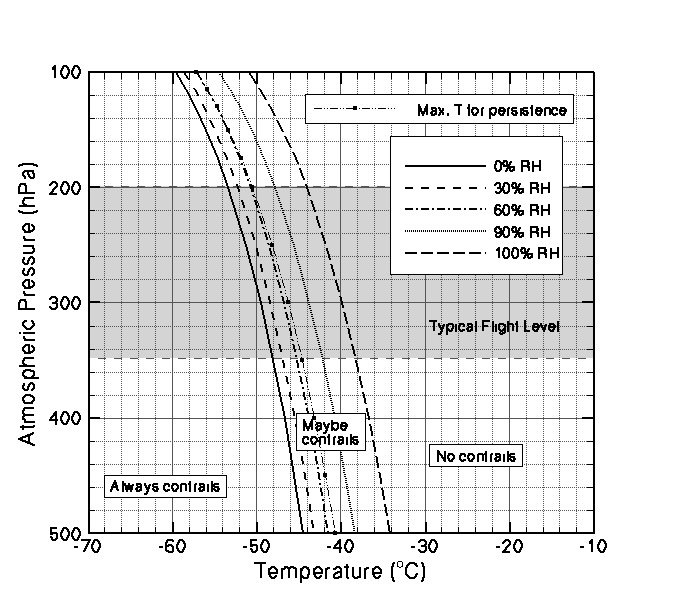
Appleman Chart Extended to Earth's Surface
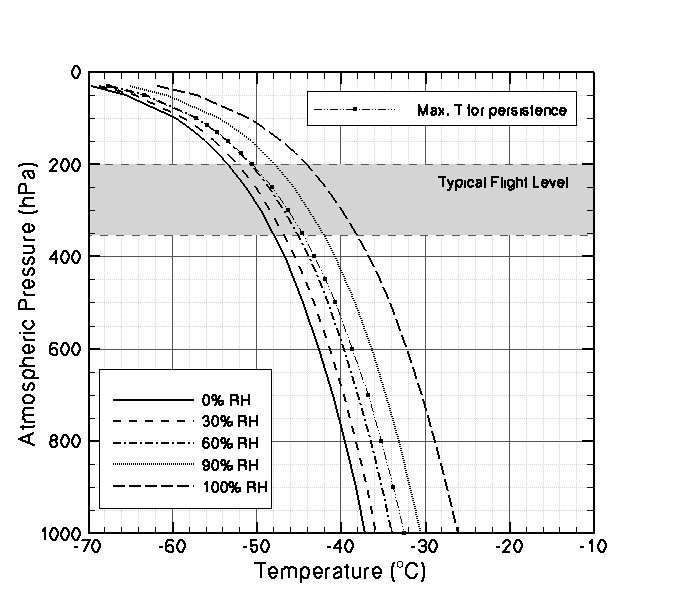
Temperature Profile: Mid-Latitude Winter
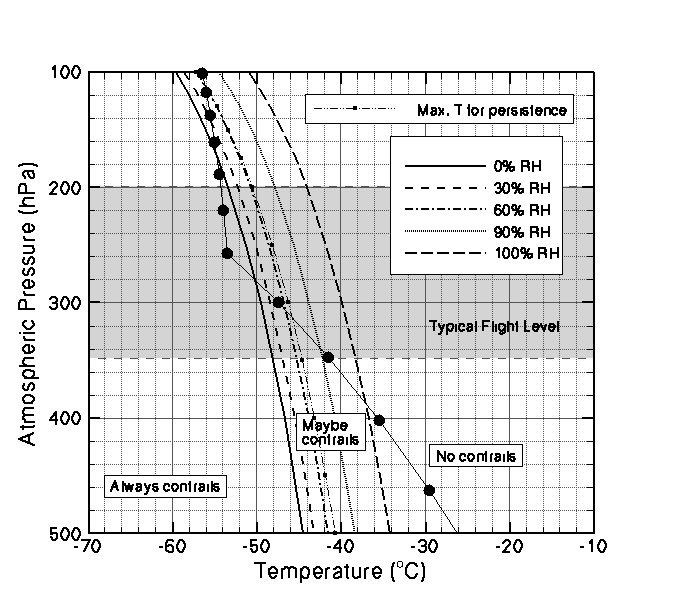
Temperature Profile: Sub-Arctic Summer
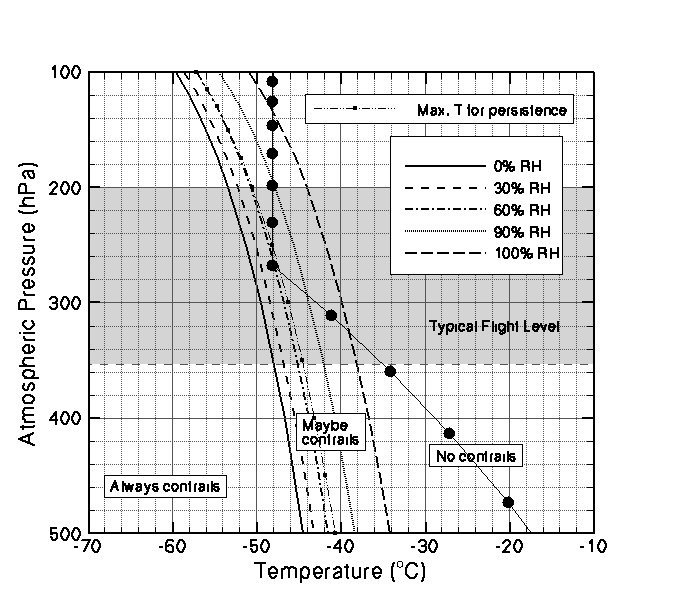
Temperature Profile: Sub-Arctic Winter
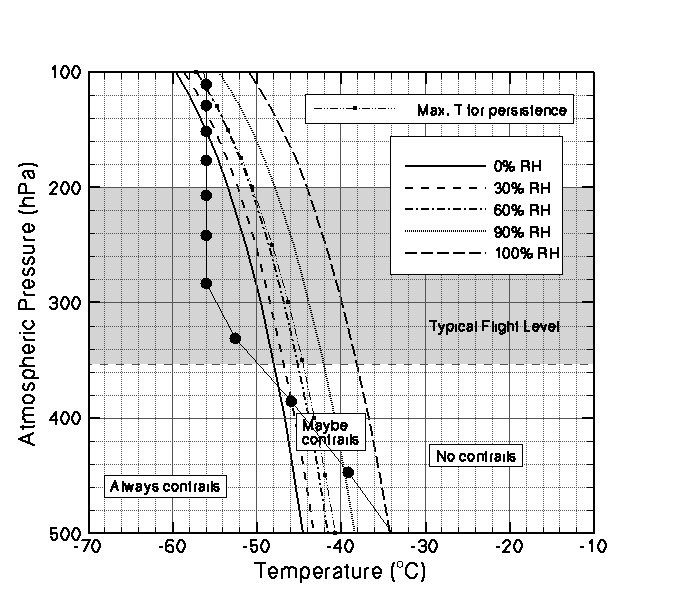
Temperature Profile: Tropical
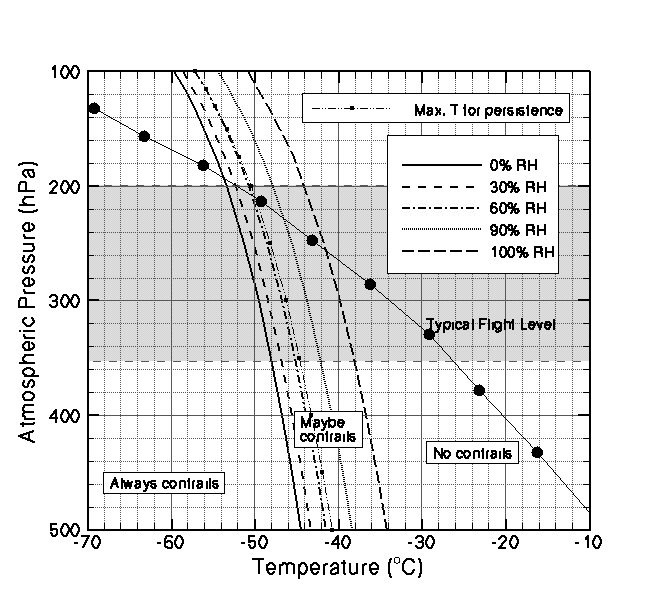
Temperature Profile: Mid-Latitude Summer
